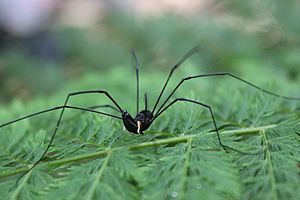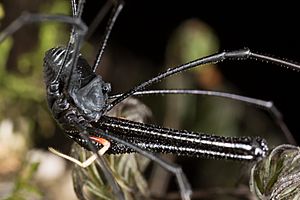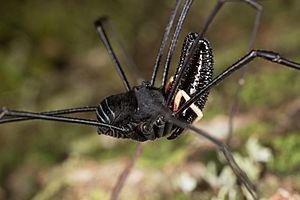Pantopsalis cheliferoides facts for kids
Quick facts for kids Pantopsalis cheliferoides |
|
|---|---|
 |
|
| Scientific classification | |
| Synonyms | |
|
Pantopsalis cheliferoides is a special type of harvestman. Harvestmen are often called 'daddy long-legs', but they are not spiders. This creature was first discovered and described by William Colenso. It is only found in New Zealand, which means it is endemic to that country.
What Does It Look Like?
Pantopsalis cheliferoides is usually dark in color. It's quite easy to tell the males and females apart because they look very different. This is called sexual dimorphism.
Male Pantopsalis cheliferoides have very large chelicerae (say: kel-ih-SER-ee), which are like their jaws. Females have much smaller jaws. What's even more interesting is that male Pantopsalis cheliferoides can have two different kinds of jaws:
- Long jaws: These jaws are very long and thin.
- Short jaws: These jaws are shorter but much wider and stronger.
The short jaws are not just smaller versions of the long ones. They are shaped differently, being thick and wide in the middle part.
Where Does It Live?
Pantopsalis cheliferoides is found only in New Zealand. This means it is endemic to New Zealand. You can find it on both of New Zealand's main islands.
How Does It Behave?
The different types of jaws in male Pantopsalis cheliferoides are used for fighting. Males often battle each other, especially over females or territory.
- Males with long jaws use them for grappling. They try to grab and hold onto their opponent.
- Males with short, wide jaws use them to stab or punch their rivals.
These different fighting styles show how important their jaws are for survival and reproduction.
Its Discovery and Name
This harvestman was first described in May 1883 by William Colenso. He named it Phalangium cheliferoides at that time. Colenso found his first specimen in a place called Seventy Mile Bush. This area is in the southern Wairarapa region, between Norsewood and Dannevirke.
Colenso spent four years trying to find this species. He saw four of them but was only able to catch one. He once saw a harvestman wave its jaws at him in a threatening way. Colenso was careful because he knew about the dangerous katipo spider in New Zealand. The harvestman escaped that time. Finally, in 1881, he caught a single specimen.
He chose the name cheliferoides because the harvestman's jaws reminded him of the Chelifer genus of pseudoscorpions.
Later, in 2000, a scientist named Cor Vink moved this species to the genus Pantopsalis. He did this after looking at Colenso's original specimen, which is now kept at the Canterbury Museum.
However, in 2004, another scientist, Christopher K. Taylor, said that the original specimen was in very poor condition. This made it hard to be sure about the species. But in 2013, after looking at many specimens from different museums, Taylor redescribed the species. He confirmed that Pantopsalis cheliferoides is indeed a unique species, different from others in its genus.



